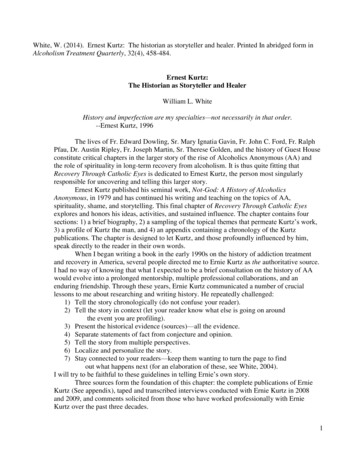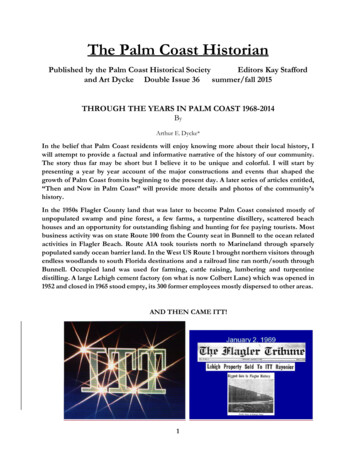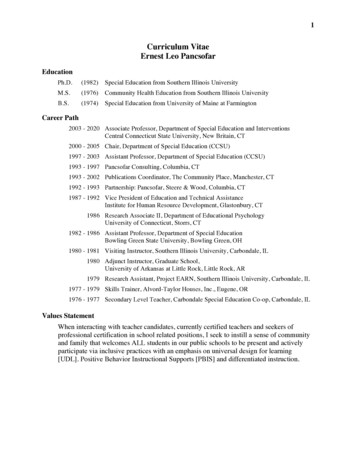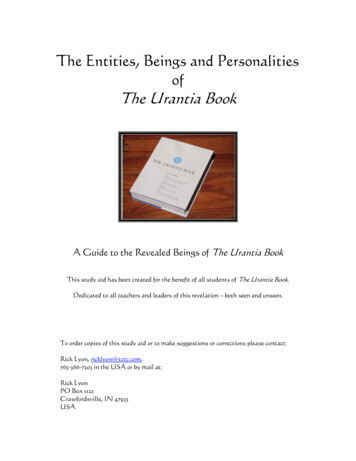
Transcription
White, W. (2014). Ernest Kurtz: The historian as storyteller and healer. Printed In abridged form inAlcoholism Treatment Quarterly, 32(4), 458-484.Ernest Kurtz:The Historian as Storyteller and HealerWilliam L. WhiteHistory and imperfection are my specialties—not necessarily in that order.--Ernest Kurtz, 1996The lives of Fr. Edward Dowling, Sr. Mary Ignatia Gavin, Fr. John C. Ford, Fr. RalphPfau, Dr. Austin Ripley, Fr. Joseph Martin, Sr. Therese Golden, and the history of Guest Houseconstitute critical chapters in the larger story of the rise of Alcoholics Anonymous (AA) andthe role of spirituality in long-term recovery from alcoholism. It is thus quite fitting thatRecovery Through Catholic Eyes is dedicated to Ernest Kurtz, the person most singularlyresponsible for uncovering and telling this larger story.Ernest Kurtz published his seminal work, Not-God: A History of AlcoholicsAnonymous, in 1979 and has continued his writing and teaching on the topics of AA,spirituality, shame, and storytelling. This final chapter of Recovery Through Catholic Eyesexplores and honors his ideas, activities, and sustained influence. The chapter contains foursections: 1) a brief biography, 2) a sampling of the topical themes that permeate Kurtz’s work,3) a profile of Kurtz the man, and 4) an appendix containing a chronology of the Kurtzpublications. The chapter is designed to let Kurtz, and those profoundly influenced by him,speak directly to the reader in their own words.When I began writing a book in the early 1990s on the history of addiction treatmentand recovery in America, several people directed me to Ernie Kurtz as the authoritative source.I had no way of knowing that what I expected to be a brief consultation on the history of AAwould evolve into a prolonged mentorship, multiple professional collaborations, and anenduring friendship. Through these years, Ernie Kurtz communicated a number of cruciallessons to me about researching and writing history. He repeatedly challenged:1) Tell the story chronologically (do not confuse your reader).2) Tell the story in context (let your reader know what else is going on aroundthe event you are profiling).3) Present the historical evidence (sources)—all the evidence.4) Separate statements of fact from conjecture and opinion.5) Tell the story from multiple perspectives.6) Localize and personalize the story.7) Stay connected to your readers—keep them wanting to turn the page to findout what happens next (for an elaboration of these, see White, 2004).I will try to be faithful to these guidelines in telling Ernie’s own story.Three sources form the foundation of this chapter: the complete publications of ErnieKurtz (See appendix), taped and transcribed interviews conducted with Ernie Kurtz in 2008and 2009, and comments solicited from those who have worked professionally with ErnieKurtz over the past three decades.1
A Prepared LifeErnest Kurtz was born September 9, 1935 —the same year AA was founded—inRochester, New York—a city whose financial and cultural history was dominated by theEastman Kodak Company and later, also by the Xerox Corporation. Also like AA, Kurtz wasborn in the heart of the Great Depression—a time when America and many alcoholics wereeconomically and spiritually hitting bottom. He was the oldest of two children born to Edwardand Josephine Kurzejewski [Koo-zhay-yev’-ski]. Ernie relates:Eight years of grammar school in a German parish shortened that name for practicaluse, and when I began graduate school bringing transcripts in two names, I wasadvised to choose one. Tired of too-lengthy phone interactions, I opted for the one thatwas easier to spell. But I do remain proud of my Polish heritage and advertise itwhenever appropriate. (Kurtz, Personal Communication, August, 2009)Josephine worked as a homemaker, and Edward, like most men in the depression era, workedin whatever job he could find to support his family. The Kurzejewski family lived in St.Boniface Parish—a close knit German neighborhood where Ernie attended Catholic grammarschool. One of his earliest childhood recollections reveals his love of learning and teaching andthe extent of his young and still developing ego.The first or second month after beginning first grade (“I remember, it still was hot”), Igathered the neighborhood kids in front of the porch of the house in which I lived, andgave a lecture on something I had just discovered. To know something was to want toteach it to others, to make it understandable. (Kurtz, 2009 Interview)Following grammar school, Kurtz entered St. Bernard’s Seminary and College inRochester. Minor seminary—four years of high school (1949-1953) and two years of college(1953-1955)—was followed by major seminary and college graduation from St. Bernard’s in1957 with a Bachelor of Arts in philosophy. Ordained to the priesthood in 1961, he wasassigned as a parish priest to Our Lady of Good Counsel in Rochester’s soon-to-be raciallymixed 19th ward. Kurtz found parish life “rewarding and fulfilling” and reveled in the variedactivities, whether preparing a sermon, performing liturgy, or working with the youth club.While visiting sick parishioners, Kurtz befriended several Jewish Rabbis who were alsovisiting the sick. It was especially from two of them, in the lunchroom of the Strong MemorialHospital, that Ernie really absorbed the power of story as a teaching device.To be more effective as a pastoral counselor, Kurtz enrolled in psychology classes atthe University of Rochester. There, he fell under the influence of Professor Marvin Becker andbecame enthralled with the history of ideas. As this interest increased, he was encouraged byhis Bishop to pursue further education. After considering several schools, Kurtz enteredHarvard University in the fall of 1966. He “ploughed a very wide and wandering path” in his12 years at Harvard, completing an MA in history in 1968 and a PhD in the History ofAmerican Civilization in 1978. Kurtz was involved in many activities during his school years,including serving as a teaching fellow at the Harvard Divinity School, returning to serve as aparish priest in Rochester (1972-1973), doing “Sunday work” for a number of parishes in theBoston area, and for a time providing pastoral coverage at a rehabilitation hospital in exchangefor room and board.Several factors influenced Kurtz’s choice of the history of Alcoholics Anonymous as a2
dissertation topic. First, slipping into his own alcoholism, he was admitted to Guest House’sthree-month treatment program for priests in 1975 after continuing to drink followingdetoxification at the Harvard Infirmary. Second, Kurtz found himself drawn to questions aboutthe history of AA while researching his original dissertation topic on the history of the city ofCleveland, Ohio.I was going to these AA meetings and was hearing things about the history of AA that Iknew couldn’t be true: “Oxford Movement” and all that. I also became very interestedin the source of the ideas upon which AA was founded. I began to investigate AAhistory and the further I got into it, the more fascinated I became. I was spending moretime on AA history than doing my doctoral research on Cleveland. On one of my visitsback to Guest House, my former counselor suggested that I should discuss my interestin AA history with Dan Anderson at Hazelden. When I met with Dan, he expressedenthusiasm and informed me that AA was about to establish an archive that wouldinclude all of Bill Wilson’s correspondence. Now that’s a graduate student’s dream—getting access to previously unviewed correspondence of some historically significantperson. (Kurtz, 2008 Interview)Getting approval to conduct a scholarly history on Alcoholics Anonymous required more thangetting such a proposal by Kurtz’s Harvard dissertation committee; it required obtainingapproval for unprecedented access to AA’s historical documents.Dan Anderson put me in touch with Dr. Milton Maxwell, who was one of the AATrustees at the time. Maxwell shared Dan’s interest in my potential work on the historyof AA. All this led me to request a switch in my dissertation topic. My Harvard mentorsapproved, as did the AA Trustee’s Archives Committee (Milton Maxwell, Joe Jackson,and George Gordon). The approval from the Archives Committee was much tougherthan my committee at Harvard. My work with these treasured documents was latersupplemented by a review of taped interviews with AA oldtimers that were on these oldreel-to-reel tapes. I had unlimited access to AA’s primary documents in a way that hadnever existed before or since. It was a truly unique opportunity, to participate in thebeginning of an archive. (Kurtz, 2008 Interview)Kurtz’s dissertation on AA was completed and approved in 1978. At the suggestion ofhis Harvard mentors and Dan Anderson, he spent the year following completion of his doctoralwork transforming his dissertation into a book. As the book neared completion, a troublingissue was raised by AA’s trustees.Milton Maxwell, who by that time, was the head of the trustees, called me, and said,“Ernie, you mention in the book Bill’s experimentation with LSD.” He went on: “Theother trustees have asked me if you would cut that from the book.” He added, “We hadthe agreement that with your dissertation there could be no censorship, but this is notthe dissertation. You’re going to publish a book.”Ouch! After a sleepless night I went to my academic mentors, Oscar Handlin and BillHutchinson, telling them, “This is what I’ve been asked. Out of respect for AA, I do notwant to do something that would be injurious to AA, though I doubt that anything Imight do will injure AA. But that does seem to me to be an important part of this story.”3
Oscar and Bill agreed, saying, “This is part of AA’s story as you tell how Wilson’sthirst for alcohol became a thirst for helping alcoholics. This thirst took many variedexpressions. That’s an essential part of your story.” So I gritted my teeth and prayedover it and decided to leave it in the book. (Kurtz, 2008 Interview)Kurtz’s Not-God: A History of Alcoholics Anonymous was published in 1979 by HazeldenPublishing.When the book was published, AA Trustees were holding their breath, concerned aboutpossible backlash for having given me such access to the archives. The first 300 callsthey received were people saying how wonderful the book was and that it revealedBill’s humanity rather than presenting him as a tin god. When the membershipresponded that way, the Trustees were happy and then respected my decision. The bookalso added to AA’s legitimacy since it was based on a dissertation approved at HarvardUniversity by one of the leading historians of our time, Oscar Handlin. (Kurtz, 2008Interview)Not-God as a scholarly document consists of two parts: 1) the history of AlcoholicsAnonymous and 2) an interpretation of the historical significance of AA in the larger context ofAmerican history and the history of religious ideas. The book meticulously details AA’s birthand evolution from 1935 into the 1970s at a level not previously nor subsequently matched,and it delves deeply into the inner workings of AA’s program of alcoholism recovery. It isremarkable, in light of AA’s growth to a membership of more than 2,000,000 members in 150countries, that Not-God remains the definitive history of Alcoholics Anonymous 30 years afterits initial publication. As partial testimony to its influence, the book has remained in print forthree decades through three editions and has sold more than 50,000 copies.On the Heels of Not-GodIn the years following its publication, the popularity of Not-God created newopportunities for Kurtz. Requests came to lecture at colleges and universities, alcoholismtreatment programs, and professional alcoholism conferences. As a result of Not-God andKurtz’s popularity as a lecturer at summer schools on alcohol studies across the country, hebecame widely known in the alcoholism field and began offering additional presentations onsuch topics as shame as an obstacle to alcoholism recovery, the role of spirituality inalcoholism recovery, and the redemptive power of storytelling.There were important turning points in the life of Ernie Kurtz during the early 1980s.Most significantly, he left the priesthood, accepted a teaching appointment at the University ofGeorgia, and met and married social worker Linda Farris, who was completing her Doctor ofPublic Administration Degree at the university. Their shared interests in self-help movementsprovided numerous later opportunities for professional collaboration. In 1982, Ernie publishedhis second book, Shame and Guilt: Characteristics of the Dependency Cycle. This workpresented one of the earliest published treatises on the distinction between shame and guilt, theroles these experiences played in the development and progression of alcoholism, and their rolein the alcoholism recovery process. It is important to note that the Kurtz treatise on shame andguilt predated the profit-motivated exploitation of these topics within pop psychology and poptherapy circles, a commodification that sorely twisted his ideas.Following Kurtz’s relocation to Chicago in 1984, he began teaching a history of4
religion class at Loyola University of Chicago. While there, he sought out various theologiansto explore his growing interest in the spiritual dimensions of AA. In 1986, Kurtz accepted anoffer to relocate and serve as the Director of Research and Education at Guest House in LakeOrion, Michigan. One of his primary responsibilities there was developing a training programfor priests who had graduated from Guest House and who were requesting guidance onfacilitating so-called “12-step retreats” in their home communities. It was in developing thistraining that he first developed the key ideas and outlines that would later evolve into the book,The Spirituality of Imperfection. The Guest House work ended when a new administratorwanted Kurtz to serve in a marketing role, to which he replied with his usual candor, “I’mhorrible at such things: you can’t be a big enough fool to ask me to do that.” Ernie left hisGuest House position in 1990 and relocated to Ann Arbor, Michigan with his wife, Linda, whohad accepted a position in the Department of Social Work at Eastern Michigan University.The Guest House years brought Ernie considerable national visibility. He was invited toserve on the editorial boards of Alcoholism Treatment Quarterly and Dionysus and deepenedhis involvement in teaching at on Rutgers University’s Summer School of Alcohol Studies.The late 1980s were also a productive writing and speaking period. Between 1986 and 1990,Kurtz authored and co-authored articles on AA, published additional work on shame, publisheda book on AA history for the lay public (AA: The Story), and made presentations related to thehistory of AA at international conferences in Canada, England, Norway, Poland, and Russia.He was also invited in 1988 to provide “An Historical Perspective on Jews in AA Recovery” atthe Third Annual JACS/Enoch V. Deutsch Memorial Lecture in New York City, which led tohis journeying to Israel with a J.A.C.S. group and lecturing on Alcoholics Anonymous to anaudience of academics and government personnel at Hebrew University in Jerusalem. Each ofthese experiences further whetted Kurtz’s interest in the varieties of spiritual experience withinAA. [J.A.C.S.: Jewish Alcoholics, Chemically Dependent Persons, and Significant Others: agroup formed by Jewish alcoholics to help other Jews understand that AA is not “a Christianprogram.”]The Spirituality of ImperfectionDuring much of the 1990s, Ernie Kurtz worked as an Adjunct Research Scientist at theCenter for Self-Help Research within the School of Social Work at the University of Michigan.He continued to lecture in venues of great prestige, but spent most of his time presenting atsmall seminaries, colleges and universities, community hospitals, and local alcoholismtreatment programs. He also continued his reading and research on AA and spirituality.Significant cultural contexts set the stage for Ernie Kurtz’s contributions during the1990s. The 1980s birthed an American culture marked by rampant materialism, perhaps bestpersonified in Gordon Gekko’s “Greed is good” speech in the 1987 movie Wall Street. Evenalcoholism treatment and recovery were commodified and aggressively marketed. Localalcoholism treatment programs initially conceived as service entities increasingly definedthemselves as businesses guided by the mantra, “margin before mission.” In time, some bothwithin and outside its fellowship expressed concern about the “corruption” of AlcoholicsAnonymous due to the growing encroachment of addiction treatment vocabulary into AAmeetings. Even some AA members began to lament the loss of “real AA.” By the early 1990s,the country, alcoholism treatment programs, and AA were trying to re-center themselves.It was within this context that Kurtz produced some of his most influential work. Thefirst of these contributions was a book drawing on a larger and longer spiritual wisdom. Kurtzdescribes how that project developed.5
Kathy Ketcham had been Jim Milam’s co-author of the book, Under the Influence, butshe felt that book lacked an understanding of the role of spirituality in recovery. Sheapproached Father James Royce, a Jesuit priest and one of the real pioneers of thealcoholism field, and invited him to do a book with her on that subject. He declined butrecommended that she should talk with me. Kathy called and raised the possibility ofcollaboration with me serving as content expert and her serving as professional writer.I was taken with her skill and obvious enthusiasm for the project, so I arranged topresent on this subject at the VA hospital in Walla Walla, Washington, close to whereKathy lived. Kathy sat in the back scribbling furiously all during the workshop, andthen we spent three days after that hammering out an outline for this book. We sentdrafts back and forth (these were the days before email) until we had the essence ofwhat became The Spirituality of Imperfection. I can be difficult to work with and a fewtimes decided that I had to send Kathy flowers as amends for my lapses from properpoliteness. (Kurtz, 2008 Interview)After an initial exploration of spirituality’s assumptions, the book delineated sixdimensions of AA spirituality (release, gratitude, humility, tolerance, forgiveness, and beingat-home) using the medium of just 100 stories. It was Kurtz’s first attempt to interpret AAspirituality to a broader public audience. When asked to explain the phenomenal culturalresponse to the book, Kurtz replied:Alcoholism is not contagious, but recovery is. Recovery of our humanity is what we’retalking about here, not recovery from a particular disorder or disease. And thisrecovery comes about in touching bottom, that hole in the middle of oneself—recognizing oneself as finite, as limited, as one who makes mistakes and does thingsthat are bad. And yet realizing that that’s not all of me. Being in touch with that hole atthe core of our being while embracing also that our being is larger than that hole—that’s what Sister Ignatia had. That’s why biographies of such people are so important.They illumine these things, especially in the lives of non-alcoholics . . . . I love ErnestBecker’s concise image and description of this: “Man is a god who shits.” We have thiscapacity for altruism, healing, profound spirituality, and yet even in those moments, weare periodically reminded of our ties to the earth, of the reality that despite all ourgrand accomplishments, we too shall decay. (Kurtz, 2008 Interview)Since its initial publication in 1994, The Spirituality of Imperfection has sold more than200,000 copies.Ernie Kurtz continued to participate in various research forums on AA and to publishscholarly pieces throughout the 1990s. Three are particularly noteworthy. In 1994, Ernie coauthored an article with William M
The first or second month after beginning first grade . parish priest in Rochester (1972-1973), doing “Sunday work” for a number of parishes in the Boston area, and for a time providing pastoral coverage at a rehabilitation hospital in exchange . A History of Alcoholics Anonymous was published in 1











